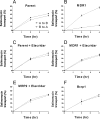P-glycoprotein limits oral availability, brain penetration, and toxicity of an anionic drug, the antibiotic salinomycin
- PMID: 18195061
- PMCID: PMC2258498
- DOI: 10.1128/AAC.01041-07
P-glycoprotein limits oral availability, brain penetration, and toxicity of an anionic drug, the antibiotic salinomycin
Abstract
Salinomycin is a polyether organic anion that is extensively used as a coccidiostatic antibiotic in poultry and commonly fed to ruminant animals to improve feed efficiency. However, salinomycin also causes severe toxicity when accidentally fed to animals in high doses. In addition, humans are highly sensitive to salinomycin and severe toxicity has been reported. Multidrug efflux transporters like P-glycoprotein (P-gp), BCRP, and MRP2 are highly expressed in the intestine and can restrict the oral uptake and tissue penetration of xenobiotics. The purpose of this study was to investigate whether the anionic drug salinomycin is a substrate for one or more of these efflux pumps. Salinomycin was actively transported by human MDR1 P-gp expressed in polarized MDCK-II monolayers but not by the known organic anion transporters human MRP2 and murine Bcrp1. Using P-gp-deficient mice, we found a marked increase in plasma salinomycin concentrations after oral administration and decreased plasma clearance after intravenous administration. Furthermore, absence of P-gp resulted in significantly increased brain penetration. P-gp-deficient mice also displayed clearly increased susceptibility to salinomycin toxicity. Thus far, P-gp was thought to affect mainly hydrophobic, positively charged or neutral drugs in vivo. Our data show that P-gp can also be a major determinant of the pharmacokinetic behavior and toxicity of an organic anionic drug. Variation in P-gp activity might thus directly affect the effective exposure to salinomycin and possibly to other anionic drugs and toxin substrates. Individuals with reduced or absent P-gp activity could therefore be more susceptible to salinomycin toxicity.
Figures



References
-
- Andreasen, J. R., and J. H. Schleifer. 1995. Salinomycin toxicosis in male breeder turkeys. Avian Dis. 39:638-642. - PubMed
-
- Borst, P., and R. Oude Elferink. 2002. Mammalian ABC transporters in health and disease. Annu. Rev. Biochem. 71:537-592. - PubMed
-
- Caldeira, C., W. S. Neves, P. M. Cury, P. Serrano, M. A. Baptista, and E. A. Burdmann. 2001. Rhabdomyolysis, acute renal failure, and death after monensin ingestion. Am. J. Kidney Dis. 38:1108-1112. - PubMed
-
- Callaway, T. R., T. S. Edrington, J. L. Rychlik, K. J. Genovese, T. L. Poole, Y. S. Jung, K. M. Bischoff, R. C. Anderson, and D. J. Nisbet. 2003. Ionophores: their use as ruminant growth promotants and impact on food safety. Curr. Issues Intest. Microbiol. 4:43-51. - PubMed
Publication types
MeSH terms
Substances
LinkOut - more resources
Full Text Sources
Medical
Miscellaneous

